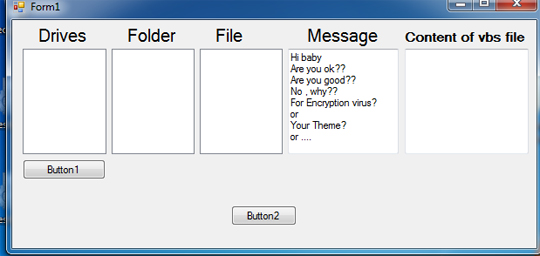RANSOM_SHIMA.A
Trojan.Ransom.Shima(ALYac); Artemis!60928336F808 (McAfee); TR/Kazy.akph (Avira (no cloud))
Windows


Threat Type: Ransomware
Destructiveness: No
Encrypted: No
In the wild: Yes
OVERVIEW
This Ransomware arrives on a system as a file dropped by other malware or as a file downloaded unknowingly by users when visiting malicious sites.
It drops files as ransom note.
TECHNICAL DETAILS
Arrival Details
This Ransomware arrives on a system as a file dropped by other malware or as a file downloaded unknowingly by users when visiting malicious sites.
Installation
This Ransomware drops the following copies of itself into the affected system:
- %Windows%\systemboot54146454.exe
(Note: %Windows% is the Windows folder, where it usually is C:\Windows on all Windows operating system versions.)
It drops the following copies of itself into the affected system and executes them:
- %User Startup%\systemboot54146454.exe
(Note: %User Startup% is the current user's Startup folder, which is usually C:\Documents and Settings\{user}\Start Menu\Programs\Startup on Windows 2000 and XP, and C:\Documents and Settings\{User name}\Start Menu\Programs\Startup on Windows Vista, 7, and 8.)
It drops the following files:
- %User Temp%\shima.themepack
(Note: %User Temp% is the user's temporary folder, where it usually is C:\Documents and Settings\{user name}\Local Settings\Temp on Windows 2000, Windows Server 2003, and Windows XP (32- and 64-bit); C:\Users\{user name}\AppData\Local\Temp on Windows Vista (32- and 64-bit), Windows 7 (32- and 64-bit), Windows 8 (32- and 64-bit), Windows 8.1 (32- and 64-bit), Windows Server 2008, and Windows Server 2012.)
It drops and executes the following files:
- %User Temp%\1.vbs
(Note: %User Temp% is the user's temporary folder, where it usually is C:\Documents and Settings\{user name}\Local Settings\Temp on Windows 2000, Windows Server 2003, and Windows XP (32- and 64-bit); C:\Users\{user name}\AppData\Local\Temp on Windows Vista (32- and 64-bit), Windows 7 (32- and 64-bit), Windows 8 (32- and 64-bit), Windows 8.1 (32- and 64-bit), Windows Server 2008, and Windows Server 2012.)
Autostart Technique
This Ransomware drops the following file(s) in the Windows Startup folder to enable its automatic execution at every system startup:
- systemboot54146454.exe
Other Details
This Ransomware does the following:
- The ransomware displays the following user interface:

- The sample is still in development and contains the following which can be edited:
- Ransom note can be edited inside the message box shown in the image above.
- Modify component file inside the content of vbs file box shown in the image above.
Ransomware Routine
This Ransomware avoids encrypting files with the following strings in their file name:
- .asa
- .asp
- .aspx
- .cs
- .css
- .htm
- .html
- .js
- .json
- .jsp
- .jst
- .php
- .php3
- .php4
- .php5
- .php6
- .php7
- .rss
- .txt
- .vbs
- .xml
It avoids encrypting files with the following strings in their file path:
- $RECYCLE.BIN
- System Volume Information
It appends the following extension to the file name of the encrypted files:
- .sh99
It drops the following file(s) as ransom note:
- {Encrypted Directory}\Encryption Message.txt
It leaves text files that serve as ransom notes containing the following text:
- Hi babyAre you ok??Are you good??No , why??For Encryption virus?orYour Theme?or ....I Do not know any thing butI know if you want open your file and Decrypt your fileyou can call me with an E-mail that is:shimabahrami99@gmail.comand I can help you just with money.If you have money send me an empty mail that its title will be "Encrypt Help".and I give you my card number and the amount of money .So after that you pay money and send me your Receipt and i check itIf it is true and real ,I give you a program that open your file ,and If it is not real ,I never give you that program.*****The first important point :If you call with a police ,I never give you program and I delete all your fileok??*****The second important point:If you do not trust me ,you can send me a filethat encrypt with my program,and mail title will be "Encrypt trust" I give you the Decrypt photo and correct fileButjust for once.asd shima99 :)
SOLUTION
Step 1
Before doing any scans, Windows XP, Windows Vista, and Windows 7 users must disable System Restore to allow full scanning of their computers.
Step 2
Note that not all files, folders, and registry keys and entries are installed on your computer during this malware's/spyware's/grayware's execution. This may be due to incomplete installation or other operating system conditions. If you do not find the same files/folders/registry information, please proceed to the next step.
Step 3
Identify and terminate files detected as RANSOM_SHIMA.A
- Windows Task Manager may not display all running processes. In this case, please use a third-party process viewer, preferably Process Explorer, to terminate the malware/grayware/spyware file. You may download the said tool here.
- If the detected file is displayed in either Windows Task Manager or Process Explorer but you cannot delete it, restart your computer in safe mode. To do this, refer to this link for the complete steps.
- If the detected file is not displayed in either Windows Task Manager or Process Explorer, continue doing the next steps.
Step 4
Search and delete these files
- %User Temp%\shima.themepack
- %User Temp%\1.vbs
- {Encrypted Directory}\Encryption Message.txt
Step 5
Scan your computer with your Trend Micro product to delete files detected as RANSOM_SHIMA.A. If the detected files have already been cleaned, deleted, or quarantined by your Trend Micro product, no further step is required. You may opt to simply delete the quarantined files. Please check the following Trend Micro Support pages for more information:
Step 6
Restore encrypted files from backup.
Did this description help? Tell us how we did.


